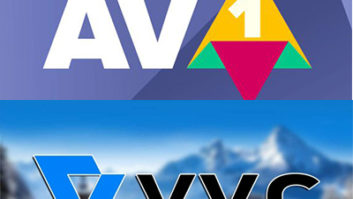It’s not that long ago that the video codec market was fairly simple with AVC (H.264) being in wide use, MPEG 2 still propping up SD broadcasting and a bubbling undercurrent of HEVC. For many today, AVC is still the go-to codec and there’s a good reason for that. Today’s technology makes encoding fairly quick and with almost universal availability of hardware decoders, it’s a safe choice for any HD delivery. There are some people, though, who see a better world. One where 4K, 8K, HDR and high frame rates are able to be delivered routinely to the average home. Two of the contenders to make this a reality are AV1 and VVC.
AV1 is a codec formed by the Alliance for Open Media (AOMedia), a collaboration between technology powerhouses such as Netflix, Google, Microsoft and Intel. AOMedia created AV1 outside the traditional standards community, but as founding members have a combined market value of over $15 trillion, there’s no shortage of momentum behind the specification. One reason for HEVC’s mixed success was access to patent pools. The patent pools surrounding HEVC were slow to form, fragmented and incomplete. In response, AOMedia built AV1 based on royalty-free codecs VP9 from Google, Daala largely from Mozilla and Thor from Cisco.
VVC’s full name is Versatile Video Coding and was finalised in late 2020, almost two years after the last release of AV1’s specification. Created by JVET, the Joint Video Exploration Team which combines the expertise of the ITU and MPEG, VVC is the successor to HEVC. ‘Versatile’ is intended to be its differentiator over pure bitrate as it includes tools to better handle computer graphics, variable frame rates, high bit depths, and 360-degree immersive video to name but a few.
Determining the future for AV1 and VVC is a nuanced affair. As the performance of each codec starts to settle, a broadcaster or streaming provider needs to ask itself which, if any, it should use. “Companies are looking for commercial and technical stability,” says Ian Nock, chair of the Ultra HD Forum Interop Working Group and founder and principal consultant, Fairmile West. “Once encoders can produce great quality live streams, this builds confidence that the implementations are well optimised. Commercial stability comes from clarity on licensing of patents.”
The European Union has announced a preliminary investigation into AOMedia’s licensing policy. They are concerned that companies who choose not to be a part of AOMedia may have AV1’s mandatory royalty-free cross licensing terms imposed on them. As no one can tell the outcome of these enquiries or how long they will continue for, this is a good example of the uncertainty that could hamper AV1 adoption in some companies.

Successful adoption of a codec relies on the broad and deep integration of that codec into all parts of the ecosystem. VVC is one codec accepted into Brazil’s TV 3.0 project, which seeks to deliver a completely new infrastructure for broadcast TV. DVB has also recently added VVC to its standards. “DVB took a leading role in the transition from analogue to digital broadcasting, then in the transition to HD with new standards such as DVB-T2.” explains Peter MacAvock, DVB chairman.
“Now the transition is to IP and broadband infrastructure as well as the ability to deliver 4K and 8K in advanced markets. To do this, we saw the need to support new codecs which could reduce video bitrates by at least 30 per cent,” he adds. “Now that we’ve defined how VVC can be used in DVB, we’re turning our attention to AVS3 and AV1.” DVB recently announced the work to add AVS3 to DVB’s media delivery toolbox was complete with AV1 set to be next.
Nock continues: “This will be the first time we’ve worked with non-MPEG codecs which is an acknowledgement that DVB is no longer purely in the broadcast space. Consistent with the way streaming providers operate, you can now choose any codec that works.”
This demonstrates DVB recognising that broadcasters who have fixed infrastructure for transmission and delivery have a different approach to change compared to streaming providers who have a much more flexible, software-heavy infrastructure allowing codecs to be trialled specifically targeted at devices with certain capabilities giving them different ways to take advantage of new technologies.
When asked if broadcasters will move to VVC or AV1, MacAvock said he expects “widespread adoption of both codecs, but not for live broadcast in the short term.” Live encoding is always difficult at the beginning of a codec’s life, but work continues apace in both the AV1 and VVC communities to get encoders working in real-time without quality compromises for all the needed resolutions. Yan Ye, head of video standards and implementation for Alibaba, has led the team writing Ali266, a software-based VVC encoder and decoder now in use in the YouKu streaming service. “As far as we know, this is the first customer-facing deployment of VVC,” explains Ye who reported on this trial to the VVC working group at JVET in January this year. “Hardware acceleration is a good thing, but we’ve shown that deploying with a software decoder is possible,” she adds.
AV1 and VVC are based on the same fundamental framework called hybrid video coding, and are more similar than different in that sense,” explains Ye. The concept of AV1 is for streaming and VVC is for broadcast is misleading. “Look at Ali266. The first thing we’ve done with VVC is streaming,” she continues. “I see today’s world as practically a multi-codec world.”
This is a sentiment echoed by Nock: “I don’t see why AV1 and VVC won’t have equal deployments, but today the footing isn’t equal. With AV1’s head start, we already see hardware AV1 decoders in mobile devices, some set top boxes and in TVs themselves.” At NAB, the Ultra HD Forum showed a demonstration of an LG TV showing the capability for VVC hardware decode of 4Kp60 HDR. “But all the VVC hardware at the moment is either a lab specimen or an FPGA demonstrating capability, not commercial readiness. I believe VVC decoders will become commercially available over the next two years,” he states.
In a few years, when manufacturers have had time to start delivering hardware decoders for both codecs, Nock sees companies weighing up many factors to find the best codec for them. “Many operators today aspire to a sweet spot of 10 to 12Mbps for live UHD, 50 per cent down from HEVC rates, and moving below that is a balance of encoding, network and CDN costs.” This already difficult balance is further challenged when bringing into play a company’s environmental sustainability goals, interoperability needs, sensitivity to royalties and hardware deployments.
The future is promising for both AV1 and VVC, but they are means to an end. While live encoders are being optimised, the broadcast infrastructure is being readied and the hardware decoders are being put in place, this is the chance for broadcasters and streaming providers to push their business models to truly make the most of these codecs’ new toolsets and abilities.







